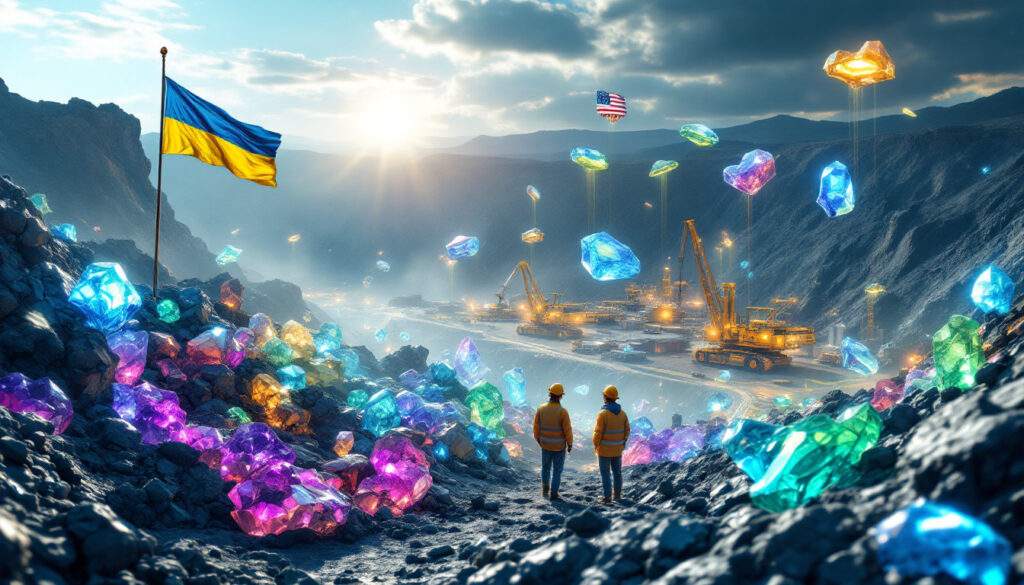Understanding the Ukraine-US Critical Minerals Agreement: Implications and Opportunities
In an increasingly electrified world dependent on advanced technologies, critical minerals have emerged as the fundamental building blocks of modern civilization. The recent landmark deal between Ukraine and the US on critical minerals represents a pivotal shift in global mineral supply chains and offers profound implications for both nations. This comprehensive analysis explores the strategic value of Ukraine's vast mineral wealth and how this partnership could reshape the geopolitical landscape of critical resources.
What Are Critical Minerals and Why Do They Matter?
Critical minerals represent the hidden backbone of our technological society—the elemental ingredients that make modern life possible. These resources are classified as "critical" because they possess two key characteristics: they're essential for important technologies and industries, and their supply chains face significant vulnerability or disruption risks.
The United States Geological Survey (USGS) identifies 50 minerals as critical, including rare earth elements, lithium, nickel, cobalt, and graphite. What makes these minerals particularly valuable is that many have no viable substitutes, creating an inherent strategic vulnerability for nations that lack domestic supplies.
The Strategic Importance of Critical Minerals
The 17 rare earth elements, despite their name, are relatively abundant in Earth's crust, but economically viable concentrations are less common. These elements have become the linchpin of modern technology, with applications including:
- Powerful magnets in electric vehicle motors and wind turbines
- Precision guidance systems in advanced weaponry
- Phosphors in energy-efficient lighting and displays
- Catalysts for petroleum refining and emissions control
Beyond rare earths, minerals like lithium and cobalt are essential for energy storage, while graphite, titanium, and manganese support everything from aerospace to medical applications. The strategic significance of these resources cannot be overstated—whoever controls critical mineral shortages gains tremendous economic and geopolitical leverage.
How Critical Minerals Drive Modern Industries
The transition to clean energy has dramatically accelerated battery minerals demand. Consider these applications:
-
Defense and Aerospace: Rare earths like neodymium and samarium power precision guidance systems, while titanium alloys provide lightweight structural components for aircraft.
-
Renewable Energy: A typical wind turbine contains approximately 600 kg of rare earth elements, primarily in the permanent magnets of generators.
-
Electric Vehicles: Each EV battery requires 8-10 kg of lithium, significant amounts of nickel and manganese, and graphite for anodes—multiplied across millions of vehicles.
-
Electronics: Smartphones contain approximately 16 different critical minerals, including indium for touchscreens and tantalum for miniaturized capacitors.
-
Medical Technology: MRI machines utilize substantial quantities of rare earth elements, while specialized surgical tools rely on unique metal alloys.
As industries evolve toward sustainability and greater technological sophistication, the demand for these minerals continues to escalate, creating an urgent need for diversified supply chains beyond traditional sources.
What Critical Mineral Resources Does Ukraine Possess?
Ukraine's geological abundance represents one of Europe's greatest untapped mineral treasures—a fact that has taken on new strategic significance following Russia's invasion and the subsequent agreement with the United States.
Ukraine's Mineral Wealth: A European Treasure
Ukraine holds deposits of 22 of the 34 minerals identified by the European Union as critical, positioning the country as a potential cornerstone of European resource security. According to Ukraine's Institute of Geology, the country possesses significant reserves of valuable rare earth elements including:
- Lanthanum and cerium: Used in catalytic converters, specialty glass manufacturing, and phosphors for LED lighting and displays
- Neodymium: Essential for permanent magnets in wind turbines and electric vehicle motors
- Erbium and yttrium: Utilized in laser technology, fiber optics, and nuclear applications
- Scandium: A lightweight metal that strengthens aluminum alloys for aerospace applications
The presence of these minerals—many of which Europe currently imports primarily from China—gives Ukraine extraordinary strategic leverage in its reconstruction and development plans.
Beyond Rare Earths: Ukraine's Diverse Mineral Portfolio
While rare earth elements capture headlines, Ukraine's mineral wealth extends far beyond these specialized metals:
- Lithium: Estimated reserves of 500,000 metric tons, representing one of Europe's largest deposits of this battery metal essential for energy storage
- Graphite: Resources accounting for approximately 20% of global reserves, critical for battery anodes and various industrial applications
- Titanium: Significant deposits in northwestern and central regions, used in aerospace, medical implants, and specialized industrial applications
- Other critical minerals: Substantial reserves of beryllium, manganese, gallium, zirconium, and nickel
This diverse portfolio positions Ukraine to support multiple critical supply chains simultaneously, rather than serving as a single-resource producer.
Geographical Distribution of Ukraine's Mineral Resources
Ukraine's critical minerals are distributed across various regions of the country, creating both challenges and opportunities:
- Lithium deposits: Concentrated in central, eastern, and southeastern regions, with major deposits in Donetsk, Kirovohrad, and Zaporizhzhia regions
- Titanium reserves: Northwestern and central areas hold significant titanium ore concentrations
- Graphite resources: Central and western regions contain major graphite deposits
- Coal reserves: Primarily in eastern territories, with much now under Russian occupation
This geographical distribution means that Ukraine must develop a regionally diverse extraction strategy, particularly given that approximately 40% of the country's metal resources are currently in Russian-occupied territories.
What Does the Ukraine-US Critical Minerals Deal Include?
After months of careful negotiations, the bilateral critical minerals agreement signed in Washington represents a multifaceted approach to resource development, economic reconstruction, and strategic cooperation.
Key Components of the Bilateral Agreement
The deal establishes several crucial mechanisms designed to benefit both nations:
- A joint investment fund dedicated specifically to Ukraine's reconstruction, with a focus on critical mineral development
- Preferential access for U.S. companies to participate in new Ukrainian mineral extraction and processing projects
- Provisions for U.S. financial contributions to the fund, though specific amounts remain undisclosed
- Potential for additional assistance packages, including defense systems, as the partnership develops
This framework creates a structured approach to mineral development while addressing Ukraine's immediate reconstruction needs.
Sovereignty Protections and Economic Safeguards
First Deputy Prime Minister Yulia Svyrydenko emphasized several crucial sovereignty protections built into the agreement:
"Ukraine retains ownership of its subsoil resources. Ukraine maintains decision-making authority over what and where to extract."
The agreement also includes important economic safeguards:
- No debt obligations for Ukraine resulting from the agreement
- Full compliance with Ukraine's constitution and ongoing EU membership aspirations
- Protection of Ukrainian worker rights and environmental standards
- Provisions for technology transfer and skill development
These protections address concerns raised by critics who feared the deal might compromise Ukraine's resource sovereignty during a vulnerable period.
What the Deal Does Not Include
Despite achieving significant objectives, the agreement falls short of some initial Ukrainian goals:
- It lacks concrete U.S. security guarantees for Ukraine, which had been discussed as a potential component
- The agreement does not provide direct American control over Ukrainian mineral extraction operations
- There are no provisions for U.S. military presence specifically related to mineral security
- The deal doesn't specify minimum investment thresholds or project timelines
These limitations highlight the pragmatic nature of the agreement—focusing on mutually beneficial economic cooperation rather than more expansive security arrangements.
How Has the War Affected Ukraine's Mineral Resources?
Russia's invasion has fundamentally altered Ukraine's ability to access and develop its mineral wealth, creating both immediate challenges and reshaping long-term development strategies.
Territorial Control and Resource Access
The war has dramatically impacted Ukraine's resource landscape:
- Approximately 20% of Ukrainian territory remains under Russian control
- About 40% of Ukraine's metal resources are in occupied areas
- Most coal deposits, previously powering Ukraine's steel industry, are now in Russian-controlled territories
- At least two significant lithium deposits have been occupied—one in Donetsk and another in Zaporizhzhia
This territorial disruption has forced Ukraine to prioritize resource development in secure western and central regions while planning for eventual recovery of eastern deposits.
Impact on Existing Mining Operations
The conflict has severely disrupted Ukraine's mining industry transformation:
- Ukraine closed its only coking coal mine outside Pokrovsk as Russian forces advanced in the region
- Infrastructure damage has impaired transportation networks, processing facilities, and power supply to mining operations
- Investment in new extraction projects has been delayed due to security concerns and risk assessment challenges
- Technical expertise has been affected by population displacement and emigration of specialized personnel
Mining operations that continued through the conflict have faced severe logistical challenges, including damaged rail infrastructure, power interruptions, and workforce shortages—all contributing to reduced output and increased operational costs.
"The war has fundamentally reshaped Ukraine's approach to resource development, prioritizing security considerations alongside economic factors."
What Investment Opportunities Does Ukraine's Mineral Sector Present?
Despite wartime challenges, Ukraine's critical minerals sector offers compelling opportunities for investors willing to take a strategic long-term perspective.
Government Initiatives and Investment Potential
Ukraine's government is aggressively working to develop its critical minerals sector:
- Officials have prepared approximately 100 sites for joint licensing and development with foreign partners
- The government estimates total investment potential at $12-15 billion by 2033
- Negotiations are ongoing with Western allies including the U.S., Britain, France, and Italy
- Regulators are streamlining permitting processes to accelerate project timelines
According to Oleksiy Sobolev, who leads Ukraine's critical raw materials development efforts, the country is positioning its mineral wealth as a cornerstone of post-war economic revival.
Competitive Advantages for Investors
Ukraine offers several distinct advantages for mineral sector investment:
- A highly qualified and relatively inexpensive labour force, including mining engineers, geologists, and metallurgists
- Developed infrastructure in non-occupied territories, including rail networks, ports, and power generation
- Proximity to European markets, reducing transportation costs and supply chain vulnerabilities
- Strong government support for foreign investment in strategic sectors, including streamlined regulatory pathways
These advantages create a compelling case for investing in mining stocks despite the ongoing security challenges in eastern regions.
Challenges to Mineral Development
Investors face several obstacles that must be addressed:
- Complex regulatory processes requiring further streamlining and transparency
- Difficulty accessing comprehensive geological data, some of which remains classified
- Challenges in obtaining land plots for exploration and development, particularly in agricultural areas
- Long development timelines requiring significant up-front investment before generating returns
- Ongoing security concerns that necessitate careful risk management strategies
These challenges require investors to take a long-term perspective while working closely with Ukrainian authorities to mitigate risks.
How Does This Deal Impact Global Critical Mineral Supply Chains?
The Ukraine-US minerals agreement represents a potential inflection point in global critical minerals supply chains, with implications extending far beyond the two signatory nations.
Reducing Dependence on China
The agreement represents a strategic effort to diversify global supply chains:
- China currently dominates production of rare earths (approximately 60% of global output) and processing of many other critical minerals
- The deal could help establish alternative supply sources for Western industries, reducing vulnerability to supply disruptions
- Ukraine's deposits could significantly reduce European dependence on Chinese imports, supporting the EU's Critical Raw Materials Act goals
- The partnership aligns with broader U.S. efforts to secure critical mineral supply chains through the Inflation Reduction Act and Defense Production Act
For Europe in particular, developing Ukraine's resources could transform the continent's industrial security by providing proximate sources for materials currently imported from distant and sometimes unreliable partners.
Timeline for Development and Production
Realistic expectations for Ukrainian mineral production must consider standard industry timelines:
- New mining projects typically require 5-10 years from exploration to commercial production
- Significant infrastructure investment will be needed in many regions, including power supply, processing facilities, and transportation networks
- Regulatory approvals and environmental assessments must be completed before major development can begin
- War recovery efforts may accelerate development in some areas while delaying it in others depending on security priorities
Industry experts caution that while Ukraine's mineral wealth is substantial, developing these resources remains a marathon rather than a sprint, requiring patience from investors and policymakers alike.
Environmental and Social Considerations
Sustainable development of Ukraine's mineral resources must address several key concerns:
- Modern extraction technologies need to be deployed to minimize environmental impact
- Community engagement and benefit-sharing mechanisms must be established to ensure local support
- Rehabilitation planning for post-mining landscapes should be integrated from project inception
- Water management and pollution prevention require particular attention in agricultural regions
Ukraine has an opportunity to implement best practices from the outset, potentially leapfrogging some of the environmental challenges faced by legacy mining operations in other countries.
What Are the Economic Implications for Ukraine?
Beyond the immediate benefits of foreign investment, the critical minerals sector could fundamentally reshape Ukraine's economic future.
Potential for Economic Transformation
The critical minerals sector could become a cornerstone of Ukraine's post-war economy:
- Creating thousands of high-skilled jobs across the country, from geologists and mining engineers to processing technicians
- Generating export revenue to support reconstruction efforts and balance of payments
- Attracting foreign direct investment in processing and manufacturing, moving beyond raw material extraction
- Developing value-added industries that utilize domestically produced critical minerals
For a country rebuilding from devastating war damage, the minerals sector offers a path to sustainable economic growth based on high-value resources rather than low-margin commodities.
Building a Sustainable Mining Industry
For long-term economic benefit, Ukraine will need to:
- Develop domestic processing capabilities rather than just exporting raw materials, capturing more of the value chain
- Invest in workforce development and technical education to ensure local communities can participate
- Create transparent governance frameworks for resource management, avoiding the "resource curse" that has plagued other mineral-rich nations
- Establish sovereign wealth mechanisms to convert mineral wealth into lasting prosperity through infrastructure and education
This approach would transform Ukraine's mineral resources from simple commodities into engines for sustainable development and industrial revival.
What Questions Remain About the Agreement?
Despite the potential benefits, several important questions remain unanswered about the Ukraine-US minerals agreement.
Implementation Challenges and Uncertainties
Several aspects of the deal require further clarification:
- Specific mechanisms for U.S. investment in Ukrainian mineral projects remain undefined
- Detailed timelines for development of priority deposits have not been published
- The exact nature of "preferential access" for U.S. companies requires legal definition
- How benefits will be shared between Ukrainian and American stakeholders needs clarification
These implementation questions will likely be addressed in subsequent agreements and regulations as the partnership develops.
Balancing Multiple International Relationships
Ukraine must navigate complex international dynamics:
- Maintaining alignment with European Union standards and requirements while implementing a bilateral U.S. agreement
- Balancing U.S. investment with opportunities for other international partners, including European companies
- Ensuring transparent and competitive bidding processes within the preferential framework
- Addressing potential concerns from neighboring countries about environmental impacts or market competition
Ukraine's strategic position between the EU and U.S. creates both opportunities and challenges as it develops its critical minerals sector, as noted in recent global market insights.
FAQ: Ukraine-US Critical Minerals Agreement
What is the estimated value of Ukraine's untapped mineral resources?
While precise valuations vary, industry experts estimate Ukraine's critical mineral resources could be worth tens of billions of dollars when fully developed. The government projects investment potential of $12-15 billion by 2033 for the sector's development, though the ultimate value would depend on commodity prices, extraction costs, and global demand patterns.
Are there currently any operational rare earth mines in Ukraine?
According to The Conversation, Ukraine currently has no commercially operational rare earth mines. Development of these resources would require significant investment in exploration, extraction, and processing infrastructure. The most advanced projects remain in the exploration and assessment phases, with production potentially beginning in the next 5-7 years with appropriate investment.
How will the agreement affect Ukraine's EU membership aspirations?
Ukrainian officials have emphasized that the agreement complies with Ukraine's EU membership campaign. The deal maintains Ukrainian sovereignty over resources while creating investment opportunities that could strengthen the country's economy ahead of potential EU accession. The agreement's focus on sustainable development and environmental protection aligns with EU priorities for the extractive sector.
What role will private companies play in developing Ukraine's minerals?
Private companies, both Ukrainian and international, will lead the actual development of mineral resources under the framework established by the agreement. The government is preparing approximately 100 sites for joint licensing and development with private sector partners. These companies will provide the technical expertise, capital investment, and market connections necessary to transform geological potential into commercial production.
How does this agreement compare to similar deals between the US and other countries?
This agreement represents a unique approach to critical minerals cooperation, combining investment for reconstruction with resource development. Unlike some arrangements with other countries, the Ukraine-US deal emphasizes Ukrainian sovereignty and avoids creating debt obligations. According to Reuters, the agreement's scope is broader than typical mining investments,
Want to Capitalise on the Next Major ASX Mineral Discovery?
Stay ahead of the market with Discovery Alert's proprietary Discovery IQ model, which instantly identifies significant mineral discoveries and translates complex geological data into actionable investment opportunities. Visit the Discovery Alert discoveries page to see how historic mineral discoveries have generated substantial returns for early investors.




